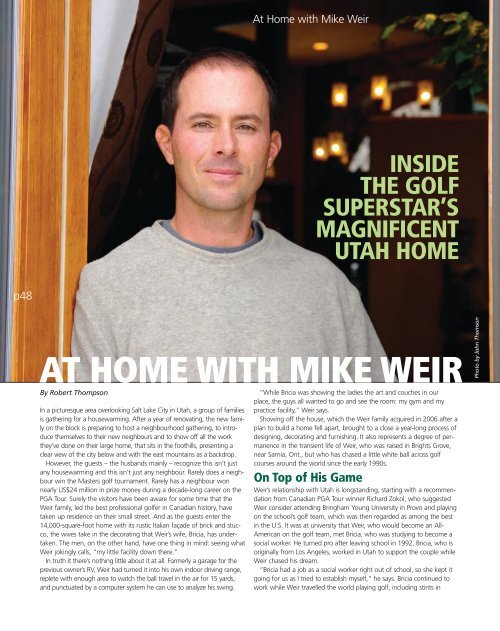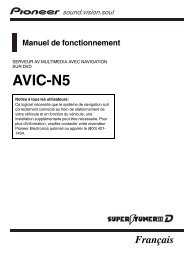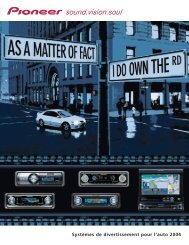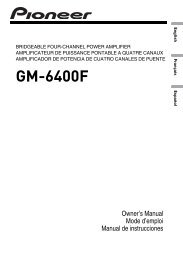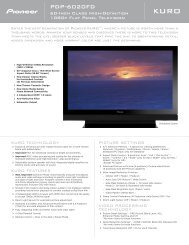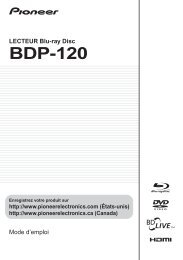AT HOME WITH MIKE WEIR Photo by John Thomson - Pioneer
AT HOME WITH MIKE WEIR Photo by John Thomson - Pioneer
AT HOME WITH MIKE WEIR Photo by John Thomson - Pioneer
Create successful ePaper yourself
Turn your PDF publications into a flip-book with our unique Google optimized e-Paper software.
At Home with Mike Weir<br />
INSIDE<br />
THE GOLF<br />
SUPERSTAR’S<br />
MAGNIFICENT<br />
UTAH <strong>HOME</strong><br />
p48<br />
<strong>AT</strong> <strong>HOME</strong> <strong>WITH</strong> <strong>MIKE</strong> <strong>WEIR</strong><br />
<strong>Photo</strong> <strong>by</strong> <strong>John</strong> <strong>Thomson</strong><br />
By Robert Thompson<br />
In a picturesque area overlooking Salt Lake City in Utah, a group of families<br />
is gathering for a housewarming. After a year of renovating, the new family<br />
on the block is preparing to host a neighbourhood gathering, to introduce<br />
themselves to their new neighbours and to show off all the work<br />
they’ve done on their large home, that sits in the foothills, presenting a<br />
clear view of the city below and with the east mountains as a backdrop.<br />
However, the guests – the husbands mainly – recognize this isn’t just<br />
any housewarming and this isn’t just any neighbour. Rarely does a neighbour<br />
win the Masters golf tournament. Rarely has a neighbour won<br />
nearly US$24 million in prize money during a decade-long career on the<br />
PGA Tour. Surely the visitors have been aware for some time that the<br />
Weir family, led the best professional golfer in Canadian history, have<br />
taken up residence on their small street. And as the guests enter the<br />
14,000-square-foot home with its rustic Italian façade of brick and stucco,<br />
the wives take in the decorating that Weir’s wife, Bricia, has undertaken.<br />
The men, on the other hand, have one thing in mind: seeing what<br />
Weir jokingly calls, “my little facility down there.”<br />
In truth it there’s nothing little about it at all. Formerly a garage for the<br />
previous owner’s RV, Weir had turned it into his own indoor driving range,<br />
replete with enough area to watch the ball travel in the air for 15 yards,<br />
and punctuated <strong>by</strong> a computer system he can use to analyze his swing.<br />
“While Bricia was showing the ladies the art and couches in our<br />
place, the guys all wanted to go and see the room: my gym and my<br />
practice facility,” Weir says.<br />
Showing off the house, which the Weir family acquired in 2006 after a<br />
plan to build a home fell apart, brought to a close a year-long process of<br />
designing, decorating and furnishing. It also represents a degree of permanence<br />
in the transient life of Weir, who was raised in Brights Grove,<br />
near Sarnia, Ont., but who has chased a little white ball across golf<br />
courses around the world since the early 1990s.<br />
On Top of His Game<br />
Weir’s relationship with Utah is longstanding, starting with a recommendation<br />
from Canadian PGA Tour winner Richard Zokol, who suggested<br />
Weir consider attending Bringham Young University in Provo and playing<br />
on the school’s golf team, which was then regarded as among the best<br />
in the U.S. It was at university that Weir, who would become an All-<br />
American on the golf team, met Bricia, who was studying to become a<br />
social worker. He turned pro after leaving school in 1992, Bricia, who is<br />
originally from Los Angeles, worked in Utah to support the couple while<br />
Weir chased his dream.<br />
“Bricia had a job as a social worker right out of school, so she kept it<br />
going for us as I tried to establish myself,” he says. Bricia continued to<br />
work while Weir travelled the world playing golf, including stints in
At Home with Mike Weir<br />
Australia where he literally ran out of money on a couple of occasions.<br />
Other times, he’d make the 11-hour drive to California to visit Mike<br />
Wilson, his swing instructor at the time. It was a difficult period during<br />
which the couple had little money and the golfer didn’t progress up the<br />
ranks as quickly as many expected.<br />
“Bricia traveled with me for three years in there,” he explains. “We’d<br />
get an apartment and when I had to go on tour we’d just put everything<br />
in storage.”<br />
That changed in 1998 when Weir made it through the daunting qualifying<br />
school: six rounds of difficult, pressure-filled golf, and finally found<br />
himself on the PGA Tour. His rookie year was far from a disaster, but he<br />
didn’t earn playing privileges for 1999. Instead he went back to Q-<br />
school, won that tournament and would become the first Canadian to<br />
win an event in Canada in more than four decades when he captured<br />
the Air Canada Championship in Vancouver. That set him up to become<br />
the best Canadian golfer in history, winning again in 2000 and 2001<br />
before his breakthrough year of 2003, when he won three times and<br />
became the first Canadian to win one of golf’s four major championships<br />
when he prevailed over Len Mattiace in a playoff at the Masters.<br />
By then the days of stuffing the family’s belongings in storage while<br />
Weir played golf was a distant memory. In Canada, Weir became a sports<br />
superstar, instantly recognizable through a series of television commercials<br />
and billboards in support of a Toronto-based mutual-fund company.<br />
He made nearly US$5-million on the course in 2003, and millions more<br />
off the course through endorsement and sponsorship deals set up <strong>by</strong> his<br />
management company, IMG Sports.<br />
As Weir’s star grew, the family, which now included daughters Elle and<br />
Lili, became more attached to Utah, especially the outdoor activities and<br />
the privacy it offered.<br />
“It was a good base and soon enough all of our friends were here,”<br />
Weir explains. “We grew to like it and loved the out-of-doors, the skiing,<br />
the lifestyle. We liked it all. And I’m definitely more anonymous here than<br />
if I lived in a golf town like Scottsdale or Orlando. Golf is big here, but no<br />
one is bugging me at the grocery store.”<br />
Making a Home<br />
On a mild day in December, Weir is enjoying a break from the rigors of<br />
professional golf. He didn’t win in 2008, but he did make more than<br />
US$3 million in a solid year. His year came to a close at the end of<br />
October, and since that point he’s spent more time at home in Utah at<br />
one stretch than he can easily recall.<br />
“I enjoy getting up, getting the girls breakfast and taking them to<br />
school,” he says. “It is about being dad.”<br />
Schooling for the girls was one of the big considerations to the location<br />
of their new home, which Bricia found during an Internet search. It<br />
With its rustic brick-and-stucco façade, Mike Weir’s 14,000-<br />
square-foot home almost looks as if it sprung from the<br />
mountains surrounding Salt Lake City, Utah. Mike’s wife<br />
Bricia worked closely with a designer for a year to create<br />
a sense of scale and comfort that suited the family.<br />
p33<br />
<strong>Photo</strong> <strong>by</strong> <strong>John</strong> <strong>Thomson</strong>
At Home with Mike Weir<br />
<strong>Photo</strong> <strong>by</strong> <strong>John</strong> <strong>Thomson</strong><br />
had been the dream project of the previous owner, whose spouse died<br />
suddenly, leaving the house largely unfinished.<br />
“It was a beautiful home, but it was a question of what we could do<br />
with it,” Weir explains. The new house was 20 minutes closer to the school<br />
the girls were attending, and had a bigger lot for outdoor activities.<br />
Located about 25 minutes outside Salt Lake City (“the highways put in<br />
place for the 2002 Olympics make it really easy to get around,” Weir says),<br />
the house offers the privacy the family was striving for while also providing<br />
the natural beauty of the mountains with the city in the distance.<br />
But its vast size presented a challenge, especially since the family didn’t<br />
want it to seem too expansive. In order to take the house from the massive<br />
shell to a homier, more comfortable setting, the Weirs employed a<br />
designer that worked with them for more than a year. Working closely<br />
with Bricia, who managed the process of redesigning the house, the goal<br />
was to make the main rooms feel less spacious. This was done <strong>by</strong> creating<br />
what Weir calls “rooms within rooms,” essentially utilizing furniture<br />
to create intimate sitting areas within some of the more expansive areas<br />
of the house. In the great room, for example, which is one of the central<br />
areas of the house, Bricia and the designer acquired a number of antique<br />
items that separated elements of the room, and utilized earth tones to<br />
p48<br />
p33<br />
<strong>Photo</strong> <strong>by</strong> <strong>John</strong> <strong>Thomson</strong><br />
The great room is the focal point of the Weirs’ Utah home. To give this expansive space a more comfortable scale, they acquired<br />
several antique items to separate various areas, and used earth tones to add warmth. So that the big <strong>Pioneer</strong> Kuro plasma TV<br />
from dominating the area, there’s a movable abstract painting in front of the screen. It rolls up when the TV is turned on, then<br />
back down, hiding the screen, when the TV is turned off.
At Home with Mike Weir<br />
<strong>Photo</strong>s <strong>by</strong> <strong>John</strong> <strong>Thomson</strong><br />
The <strong>Pioneer</strong> Kuro plasma TV in the master bedroom is installed inside a large cabinet. When it’s not in use, the screen is hidden<br />
<strong>by</strong> sliding bookshelves, which can be pushed to the side when Mike and Bricia want to catch a late-night movie.<br />
p48<br />
bring a warm sense to the area.<br />
“We wanted the house to have a cozy feel, because it was so big and<br />
open when we bought it that my vision for it wasn’t great,” Weir says.<br />
But Bricia was taken with the possibilities of the home and worked with<br />
a designer to take the Italian theme from the home’s exterior and extend<br />
it to the interior décor.<br />
Film Festival<br />
The golfer did bring one element to the home’s design: he wanted it outfitted<br />
with <strong>Pioneer</strong>’s Elite Kuro plasma televisions. Weir had first heard<br />
about the televisions from fellow PGA Tour pro Jerry Kelly, who had a<br />
sponsorship deal with <strong>Pioneer</strong>. The Weir family purchased one and put it<br />
in their ski condo in Sundance, Utah and Weir was so pleased with it that<br />
he acquired a dozen more for the new home.<br />
The Weirs are big movie watchers, often using the televisions to take in<br />
the latest Hollywood fare. And while there isn’t a lot of golf shown on<br />
the screens (though Mike occasionally tunes into the Golf Channel), he<br />
has been known to preview courses he’s not familiar with <strong>by</strong> watching<br />
videos of past tournaments. However, most of the time spent watching<br />
the televisions is focused on college sports (particularly football) and<br />
sports news programming on ESPN, which is a regular draw for Weir –<br />
though not as much for his wife, he admits.<br />
The only area on which the golfer and his wife disagreed was on how<br />
the televisions should be presented. Bricia didn’t want them dominating<br />
rooms and didn’t want one in their bedroom. Weir took a mulligan,<br />
agreeing to make the televisions in the great room and master bedroom<br />
more discreet.<br />
In the master bedroom, the <strong>Pioneer</strong> plasma is installed in the centre of<br />
a large cabinet, which Bricia found in a local boutique. When it’s not in<br />
use, the television is covered <strong>by</strong> bookshelves that slide horizontally. When<br />
the Weirs want some late night viewing, they slide the bookshelves to<br />
either side of the cabinet, uncovering the screen. When they’re done,<br />
they slide the bookshelves back into the middle to hide the screen.<br />
The great room is near the main entrance, with a big open kitchen<br />
directly behind, separated <strong>by</strong> huge stone fireplace. The living room and<br />
kitchen is where visitors tends to gather. Weir wanted a flat screen in the<br />
living room so that guests could chill out and watch a game instead of<br />
having to go into the adjoining pool room. Bricia didn’t want a big<br />
screen dominating the décor of the room. So they hid the TV. There’s a<br />
picture frame around the TV, and in front of the screen, there’s an<br />
abstract painting. When no one is actually watching the TV, the screen is<br />
completely hidden <strong>by</strong> the painting, which matches the décor beautifully.<br />
When someone turns on the TV, the painting scrolls up on a roller,<br />
uncovering the screen. Turn it off, and the painting scrolls back down,<br />
covering the screen.<br />
For music, there’s a whole-house entertainment system from a Utah<br />
company called Control 4, with speakers built into the ceiling of the living<br />
room. The Control 4 system operates a 400-disc changer and a hard<br />
disc server containing the family’s entire music collection, and can also<br />
stream music from the Rhapsody online music service. Using wall-mounted<br />
control pads, the Weirs can program in their favourite music. For<br />
Mike, that includes Canadian rock band Nickelback. Weir met the band’s<br />
bassist during a trip to Hawaii and is partial to the group’s hard-edged<br />
sound. However, big guitars aren’t the only music playing on the system.<br />
The Weir family is also partial to country music and the system was<br />
plugged full of Christmas music that played constantly when the family<br />
entertained over the holidays.<br />
“My Little Facility”<br />
In other areas of the house, the televisions and technology come to the<br />
forefront, specifically in Weir’s elaborate home gym, constructed <strong>by</strong> his<br />
trainer, Jeff Handler, and in his indoor range in the converted RV garage.<br />
Like many professional golfers, Weir has embraced the fitness revolution<br />
that has become part of the game since Tiger Woods’ emergence as the<br />
A whole-house entertainment system lets the Weirs program<br />
an evening’s worth of music using wall-mounted keypads.<br />
Music, stored on a hard-disk server and 400-disc CD changer, is<br />
played through wall and ceiling speakers.<br />
<strong>Photo</strong> <strong>by</strong> Gordon Brockhouse<br />
p33
p48<br />
p33<br />
<strong>Photo</strong> <strong>by</strong> <strong>John</strong> <strong>Thomson</strong><br />
Mike Weir works out about four days a week in his well equipped home gym. While exercising, he likes to watch ESPN on the<br />
big-screen <strong>Pioneer</strong> Kuro plasma TV.<br />
best – and most fit – player in the game in 1997. Plagued <strong>by</strong> difficulties<br />
with his back, a typical problem many golfers experience, Weir has long<br />
been very conscious of his strength and conditioning, making a gym and<br />
workout area a necessary part of the new house.<br />
Under Handler’s guidance, Weir’s gym is designed specifically for the<br />
golfer’s needs, and while there isn’t a huge amount of equipment, it has<br />
all been carefully considered.<br />
The gym includes a universal weight machine, which allows Weir to do<br />
everything from squats to bench press, as well as an elliptical trainer, a<br />
FreeMotion cable machine designed to promote strength and flexibility, and<br />
a stationary bike. An average Weir workout would probably ruin most<br />
weekend hackers. He works out – including extensive stretching – for a couple<br />
of hours most weekdays, while he watches sports on one of the everpresent<br />
<strong>Pioneer</strong> plasmas. “I’m there four days a week,” he says. “And the<br />
TV is on every morning when I’m down there, with ESPN or something.”<br />
Weir’s indoor hitting facility is the most technically sophisticated area of<br />
the house and is the envy of many PGA Tour pros, he says. The system<br />
was set up <strong>by</strong> JC Motion Video, a company based in Draper, Utah that<br />
has created computerized motion-analysis systems for some of golf’s<br />
biggest names, including Augusta National Golf Club, home of the annual<br />
Masters golf tournament, as well as famed golf instructors Rick Smith<br />
and Jim McLean, and actor Will Smith. The system was set up to allow<br />
Weir to utilize one of his screens and was installed in his house in the<br />
middle of last year.<br />
The system created for Weir has four cameras, including an overhead<br />
camera, with the television in a location that allows the golfer to immediately<br />
replay any of his swings. “I can put it on auto-repeat, slow it down,<br />
write lines on it, whatever I need to do,” he says.<br />
In 2007, the golfer began working with Andy Plummer and Mike<br />
Bennett, golf instructors known for their revolutionary “stack and tilt”<br />
swing theory. Weir learned a great deal about his swing <strong>by</strong> working with<br />
Plummer and Bennett, and became quite comfortable analyzing its<br />
nuances, something he does regularly in the indoor range at his home.<br />
“For me it is ideal because I can separate my game <strong>by</strong> working indoors<br />
and being technical and get immediate feedback,” he explains. “That way<br />
I can implement any change right away, whether it is making my irons<br />
steeper or changing the plane of my swing. But when you are on the<br />
range and you are at a tournament, you always have it in the back of your
At Home with Mike Weir<br />
mind that you’re going to play and you don’t want to be too technical.”<br />
Like the gym, Weir spends a lot of time at his hitting facility. “Basically<br />
when Bricia is trying to find me she knows where to look,” Weir says.<br />
“I’m either in the gym or the room beside it hitting balls.”<br />
Family First<br />
While it may have an ultra-sophisticated gym and golf area, it is clear that<br />
to Weir that is the practical and functional part of his home. Weir says his<br />
daughters – and specifically his 11-year-old Elle – have embraced technology<br />
in a way their father has not. Elle is the one that sends e-mail to<br />
family members or can be found listening to music in the family’s Utah<br />
home on her iPod. And it is Elle and her younger sister Lili, 8, who have<br />
one of the <strong>Pioneer</strong> plasmas televisions hooked up to a Nintendo Wii.<br />
Sometimes Weir joins in.<br />
“We don’t play much Wii Golf,” he explains. “Right now it is Rock<br />
Band and the Wii Play games: ping pong, tennis and baseball.”<br />
However, Bricia and Mike are insistent that the girls don’t spend too<br />
much time on the Wii or their computer. They make sure the pair gets<br />
out in the fresh Utah mountain air. While Weir says he likes the “physical<br />
aspect” of the Wii, it isn’t a substitute for more traditional childhood<br />
experiences, he says.<br />
“They don’t play much,” says Weir. “They burn off an hour or two<br />
after doing their homework. But we make sure they get outside, riding<br />
their bikes or jumping on the trampoline.”<br />
Family is a huge focus of Weir’s life. This past Christmas, the Weirs<br />
invited 17 family members (from both sides of the family) for the holidays.<br />
It is clear he’s thrilled to show off the finished version. And in typical<br />
Canadian understated fashion, he’s a bit sheepish about the home’s size,<br />
not wanting to appear ostentatious. But he’s also happy that the home<br />
can accommodate such a large group.<br />
“Sure the house is bigger than we wanted, but now it suits our purposes,”<br />
he says. “When we have 17 family members at Christmas, we’ll<br />
squeeze them all in. It’s the first time we’re getting everyone here at<br />
once. It’ll be great.” HH<br />
A computerized motion-analysis system in Mike Weir’s home records the golfer’s swing, then lets him analyze his technique. “For<br />
me it is ideal because I can separate my game <strong>by</strong> working indoors and being technical and get immediate feedback,” Weir<br />
explains. “That way I can implement any change right away.”<br />
p48<br />
p33<br />
<strong>Photo</strong> <strong>by</strong> <strong>John</strong> <strong>Thomson</strong>
At Home with Mike Weir<br />
GOLF GADGETS<br />
Products that<br />
will help your game<br />
p48<br />
Golf used to be about hitting a little white ball with a club. But in recent<br />
years it has become a quest to incorporate the latest technology.<br />
Take, for instance, Taylor Made’s new R9 driver. Golf superstar Mike<br />
Weir began working with the driver last fall. Known to be fastidious<br />
about his equipment, often tweaking and tinkering with it for weeks<br />
before using it in a tournament, Weir was still finding a setup he was<br />
comfortable with when he played Tiger Woods’ Chevron World<br />
Challenge in California in the middle of December.<br />
Like earlier Taylor Made drivers, the R9 utilizes “movable-weight technology,”<br />
which allows golfers to move weights in the clubhead in order<br />
to shape their shots differently. The technology is so successful that most<br />
golf companies have now incorporated it into some clubs in their roster.<br />
TM’s R9 takes the technology a step further <strong>by</strong> allowing golfers to adjust<br />
the face angle to open (for those that draw the ball) or to closed (for<br />
those that slice it). Additionally golfers can adjust the loft of the club,<br />
moving it from 8.5 degrees for those with higher swing speeds or higher<br />
launch angles, to 11.5 degrees for golfers who need to get the ball in<br />
the air more easily.<br />
Callaway is also offering a club to help golfers keep it in the fairway.<br />
The company’s FT-iQ driver (retailing at $529), with its unusual square<br />
face uses technology found in Stealth bombers and Formula-1 cars to<br />
promote distance and accuracy.<br />
Worried that the latest drivers will only allow you to hit it further into<br />
the woods? There’s a fix for that too. Currently on the market is myriad<br />
of GPS devices designed to help determine accurate yardage to the green<br />
from wherever you find your golf ball. Among the best is the GolfLogix<br />
GPS-8, which uses GPS technology from mapping giant Garmin ($275).<br />
Among the more intriguing developments is the movement towards<br />
Featuring an unusual square face, Callaway’s FT-iQ driver<br />
features technology to promote distance and accuracy.<br />
Using a Web-based program, golfers can design their own<br />
customized versions of MyJoys golf shoes, choosing colour,<br />
style, laces and even logos to place on the heel.<br />
personalization. FootJoy’s move into the personalization category with its<br />
MyJoys shoes ($189.99) is the most intriguing and entertaining. Utilizing<br />
a Web-based program, MyJoys allows<br />
golfers to pick everything from the model<br />
type to colour of the laces through to<br />
adding the logo of their favourite football<br />
team on the heel. Dozens of colours and<br />
configurations are available, allowing customers<br />
to create their own unique<br />
footwear, from classic traditional looks to<br />
bold and sporty. In fact, experimenting<br />
with combinations is almost as fun as<br />
wearing the shoes themselves.<br />
Already among the most successful<br />
products in golf history, Titleist’s ProV1<br />
($49.99) golf balls get a facelift for the<br />
2009 season. Titleist has been embroiled<br />
in a patent lawsuit with rival Callaway<br />
over the technology that goes into the<br />
ProV1, a battle that has forced the<br />
company to create a new version. As<br />
the most popular ball on the PGA Tour,<br />
Titleist promises the new version<br />
(which doesn’t infringe on Callaway<br />
patents, according to the company) will<br />
be equal to or better than the existing<br />
ProV1. HH<br />
The GolfLogix GPS-8 can<br />
store information on 20<br />
golf courses, from a database<br />
of 22,500. It calculates<br />
the distance of your last<br />
shot and tells you the<br />
distance from your current<br />
location to the green.<br />
p33
At Home with Mike Weir<br />
p48<br />
Mike Weir’s<br />
favourite<br />
courses<br />
There’s nothing particularly modern or cutting<br />
edge when it comes to Mike Weir’s<br />
taste in golf courses. As a golfer who has<br />
played and won on some of the toughest<br />
courses in the world, including Augusta<br />
National, home of the Masters, and Riviera<br />
Golf Club in Los Angeles, Calif., Weir is particularly<br />
fond of the classic courses built during<br />
the so-called Golden Age of golf design,<br />
a period starting around the turn of the<br />
20th century and ending just before World<br />
War II. These courses emphasize shot-making<br />
over power, and play to Weir’s game,<br />
which is not simply about hitting his driver<br />
300 yards at every opportunity.<br />
“I’m an analytical thinker,” explains Weir. “I<br />
like to have a game plan and I like to prepare<br />
that way heading into a tournament. It puts<br />
me at ease when I prepare in that way so<br />
when I arrive at a course like Colonial, Riviera,<br />
or Augusta, I’m playing out a strategy.”<br />
In Canada, Weir’s favourites include<br />
Hamilton Golf and Country Club in Ancaster,<br />
Ont., where the RBC Canadian Open was<br />
played in 2003 and 2006, and The National<br />
Golf Club of Canada in Woodbridge, Ont.,<br />
often regarded as one of the most difficult<br />
in the country.<br />
“I look at many of my favourite courses<br />
and I came to realize that a lot of what<br />
makes them challenging are the strategies,”<br />
he says. “It isn’t an issue of losing golf balls<br />
in fescue, or having fairways bounded <strong>by</strong><br />
endless water hazards. The great factor that<br />
many of my favourite courses have in common<br />
is that an average golfer playing the<br />
appropriate tees can have fun without being<br />
too beaten up <strong>by</strong> the experience. It is like<br />
Augusta; I’ve played with my Dad there and<br />
if he plays the correct set of tees he has a<br />
great time.”<br />
With all of these experiences now part of<br />
a decade-long PGA Tour career, Weir is venturing<br />
into designing courses, creating the<br />
firm of Weir Golf Design with Brantford,<br />
Ont. architect Ian Andrew. Several projects<br />
are in planning stages.<br />
“I’m really excited <strong>by</strong> this opportunity and<br />
the Mike Weir Design team is coming up<br />
with great ideas and concepts for our projects,”<br />
he says. “Our goal is to focus on a<br />
limited number of projects, providing a lot of<br />
attention to detail and time on each.” HH<br />
MAKING THE SHOT<br />
One of Mike Weir’s favourite Canadian golf courses is the The Hamilton<br />
Golf and Country Club in Ancaster, Ont., where the RBC Canadian Open<br />
was played in 2003 and 2006.<br />
The National Golf Club in Woodbridge, Ont. is one of Mike Weir’s<br />
favourite courses, and is regarded as one of the most challenging<br />
in Canada.<br />
<strong>Photo</strong> <strong>by</strong> Robert Thompson<br />
p33


